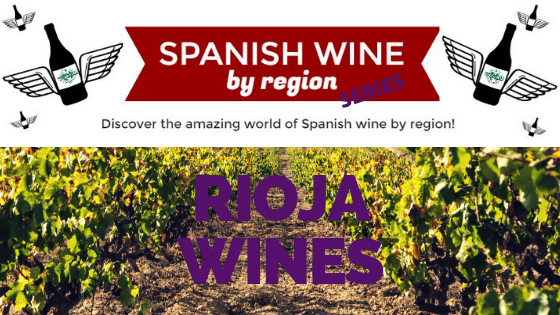SPANISH WINE BY REGION SERIES: RIOJA WINES

Moving along with our series on Spanish wine, we are now diving into the world of Rioja wines! These wines come from the autonomous regions of La Rioja and Navarre. Wines that hail from La Rioja are famous around the world for their quality and taste. Rioja is a DOCa, Denominación de Origen Calificada, which is then divided further into three zones. A wide variety of grapes grow in these zones, which we will explore further. So grab yourself a glass of your favorite wine and let’s chat all about Rioja wines!
The 3 zones of Rioja wines
Rioja Alta is located in the west of the Rioja region and has higher elevation of rolling hills than the other zones. Its elevation means that the grapes have a shorter growing season. These grapes give their wines a bright fruitiness that results in some of the best Rioja wines. It also experiences more rainfall and has a moister climate.
Rioja Baja is also a producer of very high quality wines. This is the largest zone is La Rioja, but only accounts for about 40% of all wine produced. It is dryer and has more daily sunshine that Rioja Alta, and the result is wine that is higher in sugar content and alcohol. These wines can usually reach up to 18% ABV and usually have a dark color.
Rioja Alavesa is the zone that is located farthest to the north and is also the smallest. Compared to the other regions, it is the closest to the Atlantic Ocean, which means it’s the one that most receives its cooling effects. Cool temperatures in this zone ensure that the grapes retain a good amount of acidity and color.
Grape varieties
Rioja wines are usually a mix of different grape varieties, commonly a mix of the following 6 varieties.
- Tempranillo: this is the most common grape used to make Rioja wines. These grapes have a thick skin and a very dark color, almost black. They aren’t too sweet and have a good acidic balance. Tempranillo grapes usually result in wines that range from 10.5% to 14% alcohol. While these are the most common grape, they are usually mixed with other varieties to create delicious red wine.
- Garnacha: a bit sweeter than Tempranillo grapes, Garnachas are black grapes that create high-alcohol wine. The alcohol content of Garnacha grapes can often result in wine that is as high as 15% ABV. Garnacha grapes are often blended with other varietals to add lightness and fortify the alcohol content of Rioja wines.
- Mazuelo: a black grape that has similar characteristics of Tempranillo. These grapes are high in tannins and also add longevity to wine, a key factor when it comes to aging and maturing wine in wood barrels.
- Graciano: black grapes that have a lower alcohol content. This variety is blended in with other grapes to offer freshness, lightness, and aroma. When used alone, they result in a very flavorful wine, but are often mixed in with other varieties to up the alcohol content.
- Malvasía: these grapes are acidic and low in alcohol content. A white grape variety, this is the go-to when it comes to white Rioja wines. Fresh and well-balanced.
- Viura: Often compared to Garnacha grapes in taste and alcohol content. Viura are also a staple grape when producing Rioja whites.
- Other varieties: Calagraño, Maturana, Miguel del Arco, Monastrel, Moscatel, and Turruntés.
See more: Spanish Wine by Region Series: Catalan Wines
Classifications
Rioja wines are broken into five groups, or classifications, based on their aging process. The rules are set forth by the Consejo Regulador, the body that sets the requirements for Rioja wine.
- Rioja: also known as vino joven or generic wine. There are no aging requirements for this category but the grapes must be grown in La Rioja. The entire process from grape to bottle must take place in La Rioja. Little to no aging for these wines, but fruity and fresh.
- Crianza: wine aged for about two years. Most commonly, crianza is aged in an oak barrel for half of that time and the other half in the bottle. The barrels are often used oak, so the oaky flavor isn’t too powerful or overwhelming. Fresh and more complex than generic Rioja wines.
- Reserva: 3 years of aging, at least 1 year must be in an oak barrel for red wines. Whites and rosés require 2 years of aging with at least 6 months in barrels. Sparkling wines spend 2 years en tirage, or resting. Many times, winemakers at this level will let their wines age past the minimum requirement.
- Gran Reserva: 5 years of aging, at least 2 years must be in oak barrels. These wines have a good balance of oak and fruit and a high level of tannins. Gran Reservas should be full of body and character and have a lasting flavor on the palate.
- Gran Añada: this newer category applies to sparkling wines. Winemakers harvest these wines by hand and require at least 3 years en tirage.
If you want to explore Spanish wines, join Food Lover Tour on our Urban Wine Experience in Barcelona! We take you to where the locals themselves love to drink the essential local wines and accompanying dishes!
